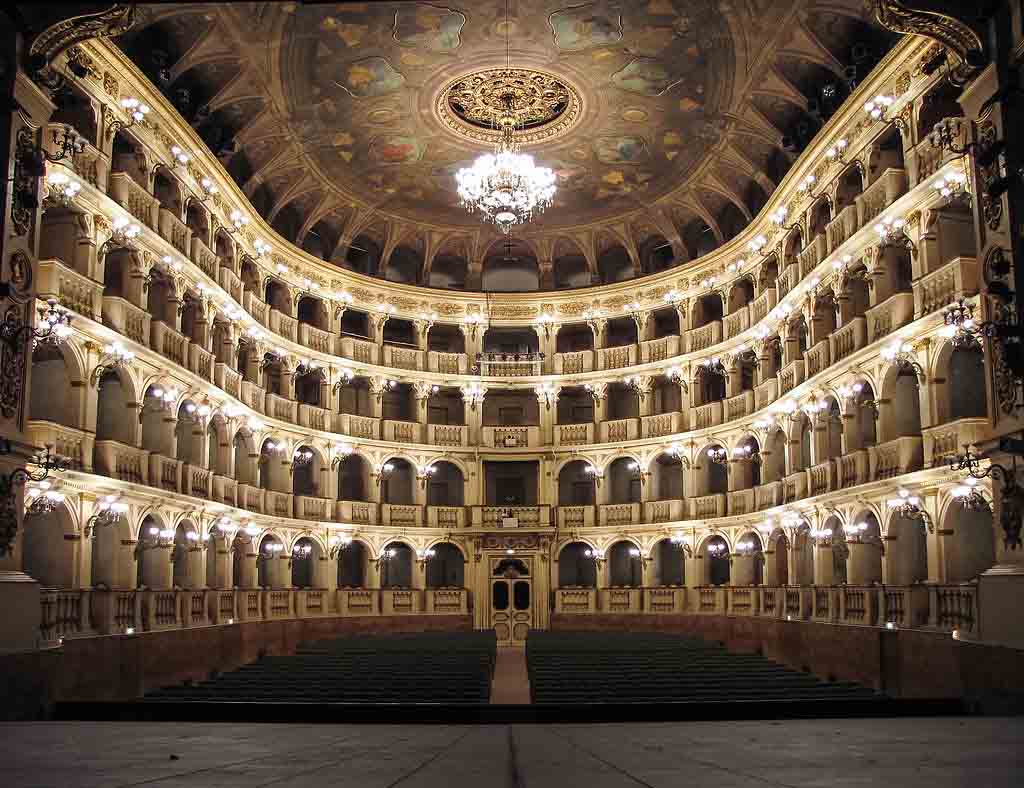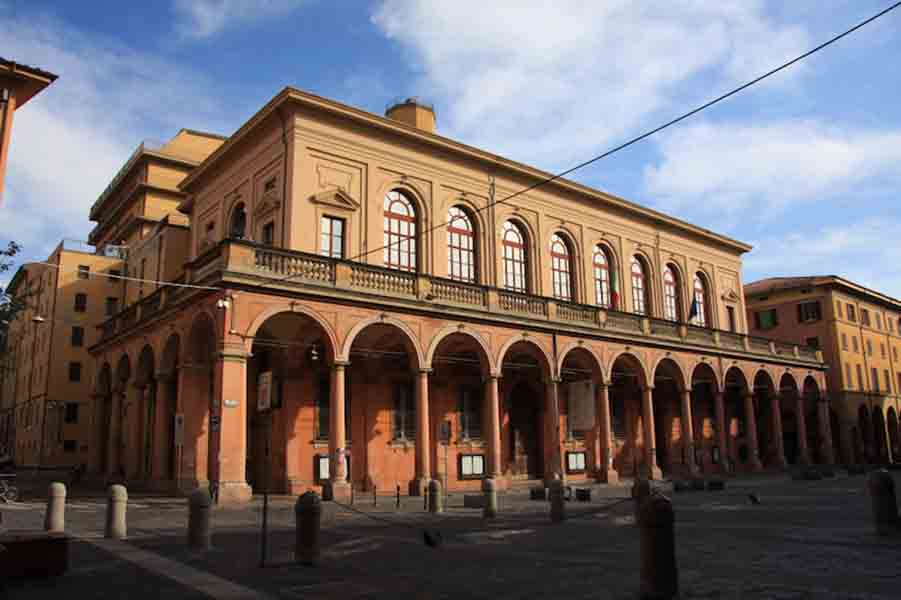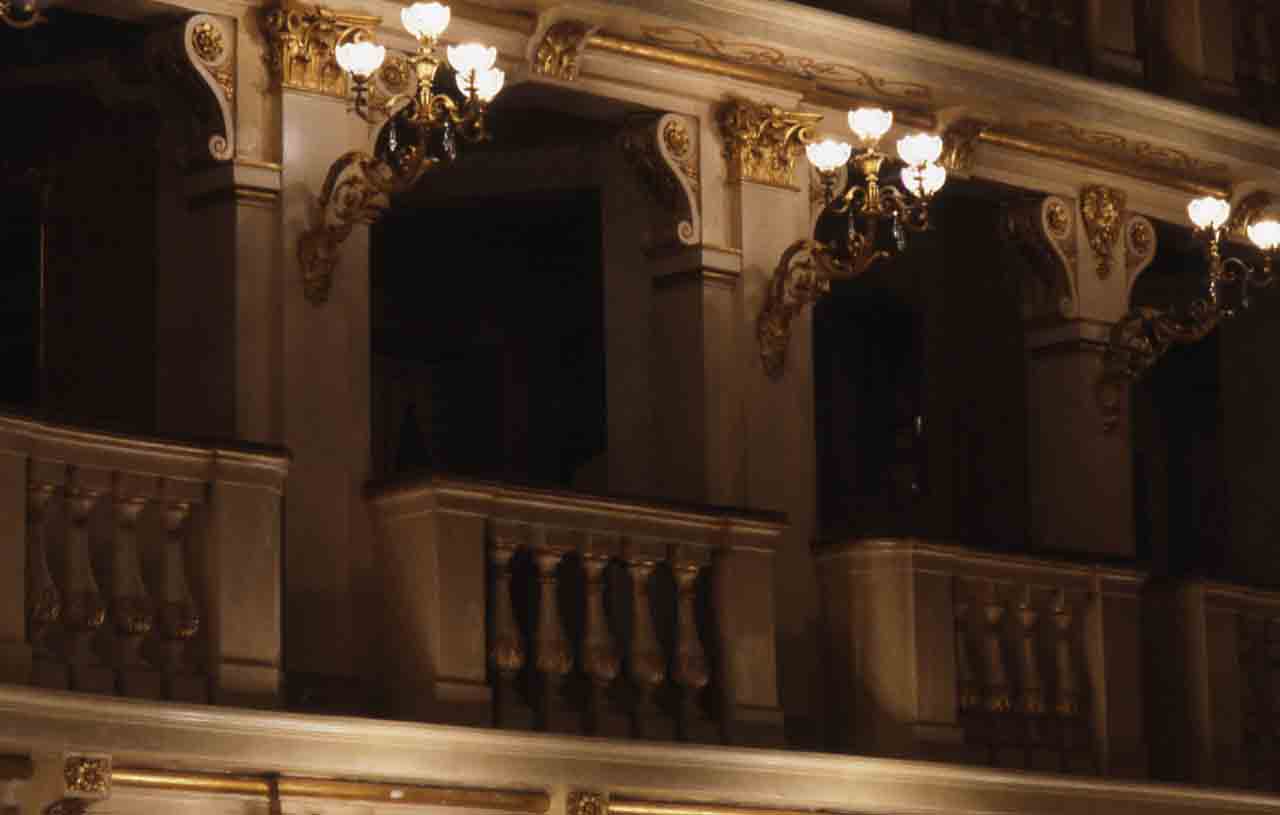Teatro Comunale
 Teatri
Teatri
Descrizione
Il Teatro Comunale di Bologna fu costruito da Antonio Galli da Bibbiena nel luogo in cui, un tempo, sorgeva Palazzo Bentivoglio, distrutto nel 1507. Una parte dei resti formano gli attuali Giardini del Guasto, compresi tra via del Guasto e Largo Respighi, dove invece c'è l'ingresso artisti.
L'auditorium, a forma di campana, è composto da quattro ordini di palchi con un palco reale e un loggione, e fu realizzato principalmente in muratura per prevenire gli incendi. Il teatro rimase a lungo incompleto, in particolare le attrezzature ospitate dietro le quinte furono terminate solo nel 1805, mentre la facciata fu completata da Umberto Rizzi nel 1933.
All'interno di molti palchi vi sono ancora le decorazioni che i palchettisti del Settecento e Ottocento facevano fare secondo i propri gusti.
Nel teatro, fin dall'inizio, si effettuarono spettacoli d'ogni genere: opere serie e buffe, commedie e tragedie, cerimonie, balli e persino numeri da circo. A tal proposito venne concepito come una vera e propria macchina meccanica dove tutto si doveva muovere. Di particolare interesse infatti è l'inconsueto sottoplatea, ove è collocata una grandiosa macchina a pantografo la quale serviva a sollevare, abbassare e basculare l'intera platea. Il meccanismo è formato da una puleggia che, facendola girare sul proprio asse, fa muovere una ruota, la quale demoltiplica il movimento a due "rocchetti" di minori dimensioni posti sui due lati opposti; a loro volta, girando, muovono un bilanciere che con un movimento a pantografo tira verso il basso o spinge verso l'alto (a seconda di come e quale "rocchetto" viene fatto girare) la platea soprastante. Il parallelismo fra i due elementi del bilanciere consente anche il basculaggio. Tutte le varie parti del meccanismo sono collegate da una corda. Non essendo più necessari questo tipo di movimenti, oggi il meccanismo è stato bloccato, tuttavia sarebbe ancora perfettamente funzionante.
In seno al teatro, il 4 febbraio 1956 nasce l'Orchestra stabile, sotto forma di associazione. Nel corso degli anni, l'Orchestra ha ospitato nelle sue esibizioni grandi musicisti, fra cui Igor Stravinskij e Aaron Copland, e ha partecipato a tournée internazionali, come quella in Giappone nel 1993 accolta con grande entusiasmo.
L'Orchestra, che si avvale della partecipazione di 95 professori d'orchestra, a cui si aggiungono i 70 elementi del Coro, svolge un'intensa attività concertistica in tutto il mondo, e opera anche nell'ambito delle colonne sonore: ha eseguito, per esempio, l'intermezzo della Cavalleria Rusticana nel film Toro scatenato di Martin Scorsese.
Nel 1998 l'Orchestra del Teatro Comunale di Bologna riceve dall'allora sindaco Walter Vitali il Nettuno d'oro, una delle massime onorificenze della città.
Nel 2008 dall'Orchestra nasce la Filarmonica del Teatro Comunale di Bologna.
Fonte: Wikipedia
The Teatro Comunale di Bologna is an opera house in Bologna, Italy, and is one of the most important opera venues in Italy. Typically, it presents eight operas with six performances during its November to April season.
While there had been various theatres presenting opera in Bologna since the early 17th century, they had either fallen into disuse or burnt down. However, from the early 18th century, the Teatro Marsigli-Rossi had been presenting operatic works by popular composers of the day including Vivaldi, Gluck, and Niccolò Piccinni. The Teatro Malvezzi, built in 1651, burned down in February 1745 and this event prompted the construction of a new public theatre, the Nuovo Teatro Pubblico, as the Teatro Comunale was first called when it opened on 14 May 1763.
Although he had been opposed by several others who lost the design competition, it was won by the architect Antonio Galli Bibiena and the theatre's inaugural performance was Gluck's Il trionfo di Clelia, an opera which the composer had written for the occasion. A bell-shaped auditorium consisting of four tiers of boxes plus a royal box and small gallery with a ceiling decorated as if open to the sky was built primarily of masonry as a protection against fire. However, much work remained unfinished, the facade in particular which was not completed until 1936. Also, many of the backstage facilities which would allow for the presentations of operas were unfinished and only completed due to competition from another theatre in 1805.
It was to be the first major opera house to be constructed with public funds and owned by the municipality. Although 35 of its 99 boxes were sold for private use, the terms of ownership were also unique in that they have been described as being limited to "the right to rent in perpetuity" rather than outright ownership and control.
Various renovations were undertaken between 1818 and 1820 and also in 1853/54. After fire destroyed much of the stage area in 1931, the theatre was closed, and it did not re-open until 14 November 1935. By that date, the original bell-shaped auditorium had given way to a horseshoe-shaped one seating 1,034 people.
The 19th century saw the presentation of twenty operas by Gioacchino Rossini, while seven of Vincenzo Bellini's ten operas were presented in the 1830s. Works by Giuseppe Verdi and, later in 1871, the Italian premiere of Richard Wagner's Lohengrin, dominated the theatre's repertoire as the century progressed. In fact, Bologna became the location for several other Wagner opera premieres in Italy, notably with the composer present for his Rienzi and the Parsifal premiere on 1 January 1914.
Another major figure associated with the Teatro Comunale from 1894 onwards was the conductor Arturo Toscanini who presented Verdi's Falstaff in that year and conducted there until the Second World War.
Credits: Wikipedia



